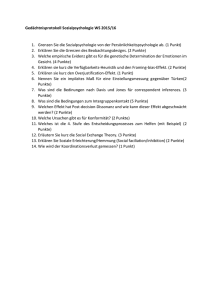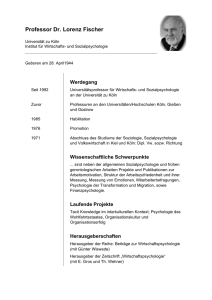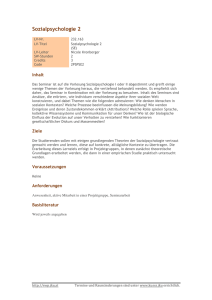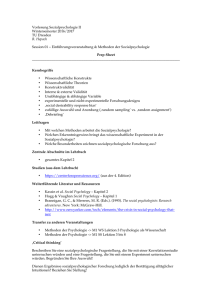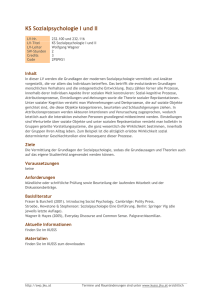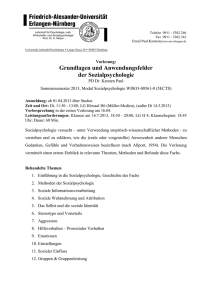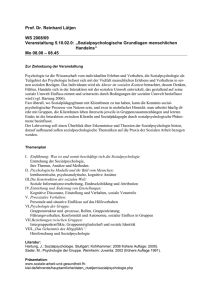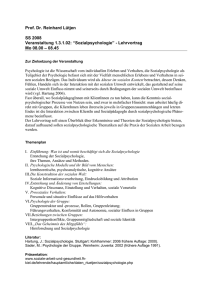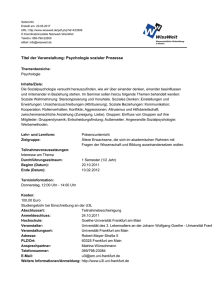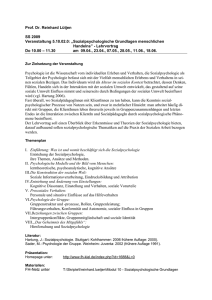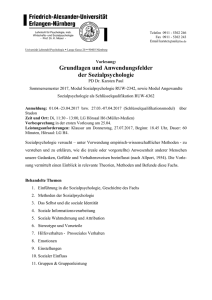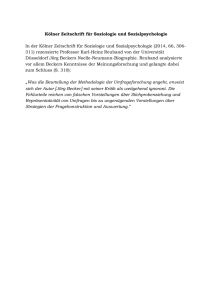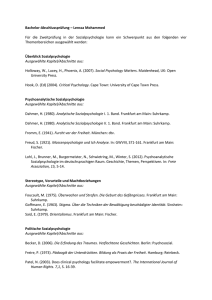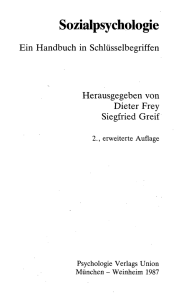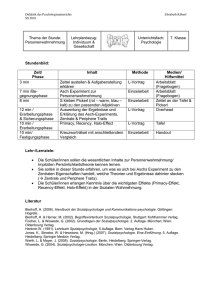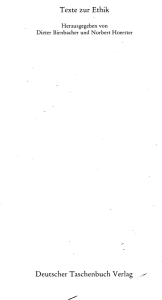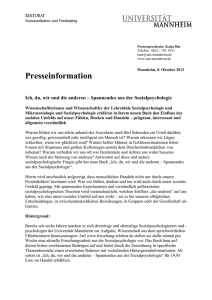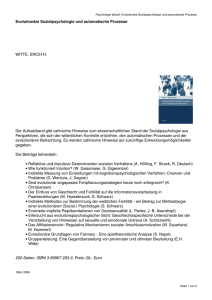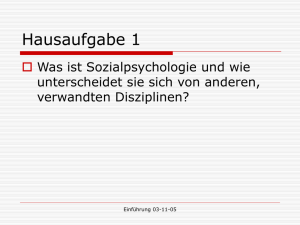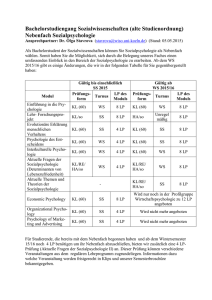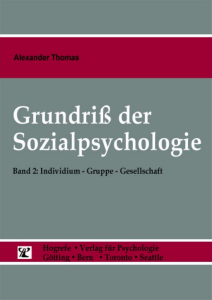01 Inhalt Sozialpsychologie.indd
Werbung
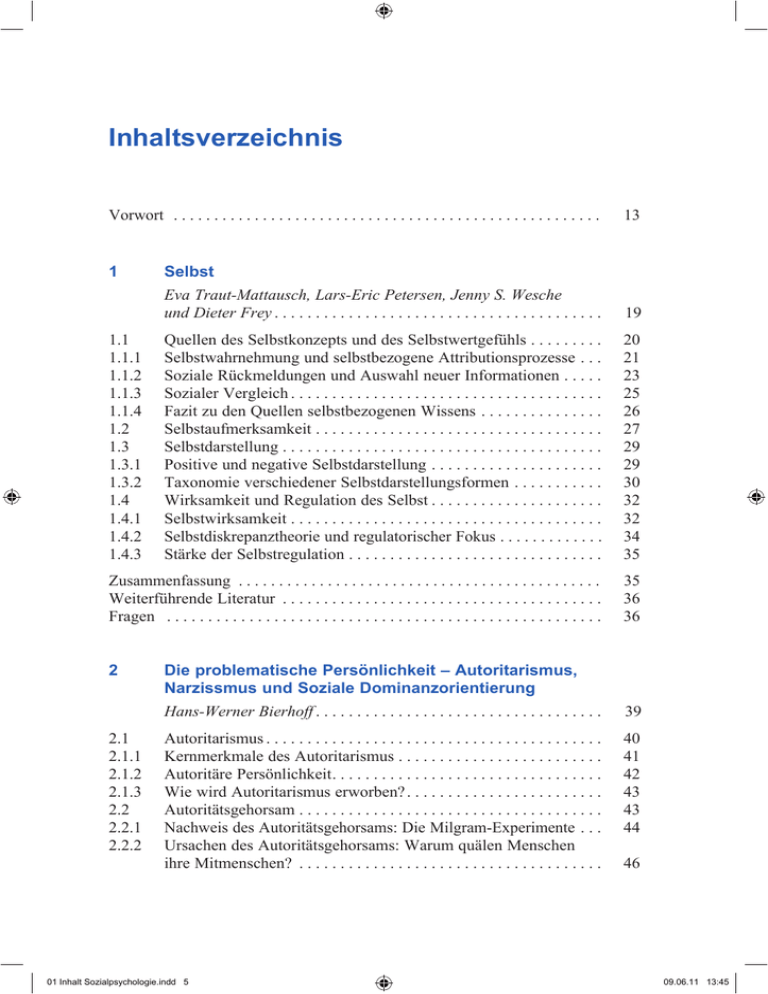
Inhaltsverzeichnis Vorwort . . . . . . . . . . . . . . . . . . . . . . . . . . . . . . . . . . . . . . . . . . . . . . . . . . . . . 1 13 Selbst Eva Traut-Mattausch, Lars-Eric Petersen, Jenny S. Wesche und Dieter Frey . . . . . . . . . . . . . . . . . . . . . . . . . . . . . . . . . . . . . . . . 19 Quellen des Selbstkonzepts und des Selbstwertgefühls . . . . . . . . . Selbstwahrnehmung und selbstbezogene Attributionsprozesse . . . Soziale Rückmeldungen und Auswahl neuer Informationen . . . . . Sozialer Vergleich . . . . . . . . . . . . . . . . . . . . . . . . . . . . . . . . . . . . . . Fazit zu den Quellen selbstbezogenen Wissens . . . . . . . . . . . . . . . Selbstaufmerksamkeit . . . . . . . . . . . . . . . . . . . . . . . . . . . . . . . . . . . Selbstdarstellung . . . . . . . . . . . . . . . . . . . . . . . . . . . . . . . . . . . . . . . Positive und negative Selbstdarstellung . . . . . . . . . . . . . . . . . . . . . Taxonomie verschiedener Selbstdarstellungsformen . . . . . . . . . . . Wirksamkeit und Regulation des Selbst . . . . . . . . . . . . . . . . . . . . . Selbstwirksamkeit . . . . . . . . . . . . . . . . . . . . . . . . . . . . . . . . . . . . . . Selbstdiskrepanztheorie und regulatorischer Fokus . . . . . . . . . . . . . Stärke der Selbstregulation . . . . . . . . . . . . . . . . . . . . . . . . . . . . . . . 20 21 23 25 26 27 29 29 30 32 32 34 35 Zusammenfassung . . . . . . . . . . . . . . . . . . . . . . . . . . . . . . . . . . . . . . . . . . . . . Weiterführende Literatur . . . . . . . . . . . . . . . . . . . . . . . . . . . . . . . . . . . . . . . Fragen . . . . . . . . . . . . . . . . . . . . . . . . . . . . . . . . . . . . . . . . . . . . . . . . . . . . . 35 36 36 1.1 1.1.1 1.1.2 1.1.3 1.1.4 1.2 1.3 1.3.1 1.3.2 1.4 1.4.1 1.4.2 1.4.3 2 2.1 2.1.1 2.1.2 2.1.3 2.2 2.2.1 2.2.2 Die problematische Persönlichkeit – Autoritarismus, Narzissmus und Soziale Dominanzorientierung Hans-Werner Bierhoff . . . . . . . . . . . . . . . . . . . . . . . . . . . . . . . . . . . 39 Autoritarismus . . . . . . . . . . . . . . . . . . . . . . . . . . . . . . . . . . . . . . . . . Kernmerkmale des Autoritarismus . . . . . . . . . . . . . . . . . . . . . . . . . Autoritäre Persönlichkeit . . . . . . . . . . . . . . . . . . . . . . . . . . . . . . . . . Wie wird Autoritarismus erworben? . . . . . . . . . . . . . . . . . . . . . . . . Autoritätsgehorsam . . . . . . . . . . . . . . . . . . . . . . . . . . . . . . . . . . . . . Nachweis des Autoritätsgehorsams: Die Milgram-Experimente . . . Ursachen des Autoritätsgehorsams: Warum quälen Menschen ihre Mitmenschen? . . . . . . . . . . . . . . . . . . . . . . . . . . . . . . . . . . . . . 40 41 42 43 43 44 01 Inhalt Sozialpsychologie.indd 5 46 09.06.11 13:45 6 2.2.3 2.2.4 Inhaltsverzeichnis Das Beispiel des administrativen Gehorsams . . . . . . . . . . . . . . . . . Autoritätsgehorsam im 21. Jahrhundert: Geschwächt oder immer noch stark? . . . . . . . . . . . . . . . . . . . . . . . . . . . . . . . . . . . . . . Genetische Determiniertheit des Autoritätsgehorsams . . . . . . . . . . Narzissmus: Wenn es sehr persönlich wird . . . . . . . . . . . . . . . . . . Narzissmus in der Psychoanalyse . . . . . . . . . . . . . . . . . . . . . . . . . . Narzissten sind sozial unverträglich . . . . . . . . . . . . . . . . . . . . . . . . Gesunder und ungesunder Narzissmus . . . . . . . . . . . . . . . . . . . . . . Soziale Dominanzorientierung . . . . . . . . . . . . . . . . . . . . . . . . . . . . Durch welche Merkmale ist Soziale Dominanzorientierung gekennzeichnet? . . . . . . . . . . . . . . . . . . . . . . . . . . . . . . . . . . . . . . . Gegenmaßnahmen bei Bedrohung der eigenen Dominanzerwartung . . . . . . . . . . . . . . . . . . . . . . . . . . . . . . . . . . . . . . . . . . . . . 47 Zusammenfassung. . . . . . . . . . . . . . . . . . . . . . . . . . . . . . . . . . . . . . . . . . . . . Weiterführende Literatur . . . . . . . . . . . . . . . . . . . . . . . . . . . . . . . . . . . . . . . . Fragen . . . . . . . . . . . . . . . . . . . . . . . . . . . . . . . . . . . . . . . . . . . . . . . . . . . . . 58 59 59 2.2.5 2.3 2.3.1 2.3.2 2.3.3 2.4 2.4.1 2.4.2 3 48 50 51 51 53 54 55 55 56 Konsistenztheorien Claudia Peus, Dieter Frey und Susanne Braun . . . . . . . . . . . . . . . 61 Grundannahmen der Dissonanztheorie . . . . . . . . . . . . . . . . . . . . . . Dissonanzreduktion . . . . . . . . . . . . . . . . . . . . . . . . . . . . . . . . . . . . . Situationen, in denen Dissonanz und deren Reduktion häufig auftreten . . . . . . . . . . . . . . . . . . . . . . . . . . . . . . . . . . . . . . . . . . . . . . Bedingungen, unter denen eine Dissonanzreduktion häufig nicht nachweisbar ist . . . . . . . . . . . . . . . . . . . . . . . . . . . . . . . . . . . . Anwendungsgebiete . . . . . . . . . . . . . . . . . . . . . . . . . . . . . . . . . . . . Die Theorie der kognitiven Balance . . . . . . . . . . . . . . . . . . . . . . . . Kongruitätstheorie (Osgood und Tannenbaum) und affektivkognitive Konsistenztheorie (Rosenberg) . . . . . . . . . . . . . . . . . . . . 63 64 Zusammenfassung . . . . . . . . . . . . . . . . . . . . . . . . . . . . . . . . . . . . . . . . . . . . Weiterführende Literatur . . . . . . . . . . . . . . . . . . . . . . . . . . . . . . . . . . . . . . . Fragen . . . . . . . . . . . . . . . . . . . . . . . . . . . . . . . . . . . . . . . . . . . . . . . . . . . . . 82 83 83 3.1 3.2 3.2.1 3.2.2 3.3 3.4 3.5 4 4.1 64 72 74 76 80 Das Streben nach Kontrolle: Menschen zwischen Freiheit und Hilflosigkeit Immo Fritsche, Eva Jonas, Eva Traut-Mattausch und Dieter Frey . . . . . . . . . . . . . . . . . . . . . . . . . . . . . . . . . . . . . . . . . . . 85 Kontrolle und Kontrollmotivation . . . . . . . . . . . . . . . . . . . . . . . . . 87 01 Inhalt Sozialpsychologie.indd 6 09.06.11 13:45 Inhaltsverzeichnis 4.1.1 4.1.2 4.1.3 4.2 4.2.1 4.2.2 4.2.3 4.2.4 4.3 4.3.1 4.3.2 4.3.3 Kontrolle . . . . . . . . . . . . . . . . . . . . . . . . . . . . . . . . . . . . . . . . . . . . . Kontrollmotivation . . . . . . . . . . . . . . . . . . . . . . . . . . . . . . . . . . . . . Wege zur Kontrolle . . . . . . . . . . . . . . . . . . . . . . . . . . . . . . . . . . . . . Konsequenzen von Kontrolle und Kontrollverlust . . . . . . . . . . . . . Auswirkungen primärer Kontrolle . . . . . . . . . . . . . . . . . . . . . . . . . Kontrolle und der Umgang mit Stress und Bedrohung . . . . . . . . . Folgen von Kontrollverlust . . . . . . . . . . . . . . . . . . . . . . . . . . . . . . . Reaktanz und Hilflosigkeit . . . . . . . . . . . . . . . . . . . . . . . . . . . . . . . Kontrolle als soziales Phänomen . . . . . . . . . . . . . . . . . . . . . . . . . . Kontrolle als Folge sozialer Prozesse . . . . . . . . . . . . . . . . . . . . . . . Die Auswirkungen von Kontrolle auf soziale Prozesse . . . . . . . . . Kollektive Kontrolle . . . . . . . . . . . . . . . . . . . . . . . . . . . . . . . . . . . . 7 87 90 93 96 96 97 100 102 105 105 106 108 Zusammenfassung. . . . . . . . . . . . . . . . . . . . . . . . . . . . . . . . . . . . . . . . . . . . . 109 Weiterführende Literatur . . . . . . . . . . . . . . . . . . . . . . . . . . . . . . . . . . . . . . . . 110 Fragen . . . . . . . . . . . . . . . . . . . . . . . . . . . . . . . . . . . . . . . . . . . . . . . . . . . . . 110 5 Interpersonale Attraktion Hans-Werner Bierhoff . . . . . . . . . . . . . . . . . . . . . . . . . . . . . . . . . . . 111 5.1 5.2 5.2.1 5.2.2 5.2.3 5.2.4 5.3 5.4 5.4.1 5.4.2 5.4.3 5.5 5.6 5.6.1 5.6.2 Positive Bewertung persönlicher Eigenschaften: Der Effekt des „Gemocht-werdens“ . . . . . . . . . . . . . . . . . . . . . . . . Ähnlichkeit oder Gegensätzlichkeit? . . . . . . . . . . . . . . . . . . . . . . . Verstärkungs-Affekt-Modell der Attraktion . . . . . . . . . . . . . . . . . . Ähnlichkeit in Persönlichkeitsmerkmalen . . . . . . . . . . . . . . . . . . . Gegenseitigkeit des Mögens . . . . . . . . . . . . . . . . . . . . . . . . . . . . . . Rolle der Information und kognitive Schlussfolgerungen . . . . . . . Balancetheorie: Harmonische Systeme fördern die interpersonale Harmonie . . . . . . . . . . . . . . . . . . . . . . . . . . . . . . . . . . . . Nähe und Häufigkeit des Zusammentreffens . . . . . . . . . . . . . . . . . Untersuchung zum Einfluss der räumlichen Nähe . . . . . . . . . . . . . Mere exposure-Phänomen . . . . . . . . . . . . . . . . . . . . . . . . . . . . . . . Mere exposure in Gruppen . . . . . . . . . . . . . . . . . . . . . . . . . . . . . . . Perfektion und Attraktion: Komplexe Zusammenhänge . . . . . . . . Aktual-Selbst und Ideal-Selbst . . . . . . . . . . . . . . . . . . . . . . . . . . . . Übereinstimmung mit dem Ideal-Selbst steigert interpersonale Attraktion . . . . . . . . . . . . . . . . . . . . . . . . . . . . . . . . . . . . . . . . . . . . Selbstwertbedrohung durch außergewöhnliche Personen? . . . . . . 113 113 114 116 119 120 121 123 123 123 124 125 126 126 127 Zusammenfassung . . . . . . . . . . . . . . . . . . . . . . . . . . . . . . . . . . . . . . . . . . . . 128 Weiterführende Literatur . . . . . . . . . . . . . . . . . . . . . . . . . . . . . . . . . . . . . . . 129 Fragen . . . . . . . . . . . . . . . . . . . . . . . . . . . . . . . . . . . . . . . . . . . . . . . . . . . . . 129 01 Inhalt Sozialpsychologie.indd 7 09.06.11 13:45 8 6 Inhaltsverzeichnis Physische Attraktivität Hans-Werner Bierhoff . . . . . . . . . . . . . . . . . . . . . . . . . . . . . . . . . . . 131 6.1 6.1.1 6.1.2 6.1.3 6.2 6.2.1 6.2.2 6.3 6.4 6.4.1 6.4.2 Stereotyp der Schönheit . . . . . . . . . . . . . . . . . . . . . . . . . . . . . . . . . Physische Attraktivität, soziale Kompetenz und Persönlichkeit . . . Sich-selbst-erfüllende Prophezeiung . . . . . . . . . . . . . . . . . . . . . . . Erklärung durch Evolutionspsychologie . . . . . . . . . . . . . . . . . . . . . Gesichtsattraktivität . . . . . . . . . . . . . . . . . . . . . . . . . . . . . . . . . . . . Soziale Eindrucksbildung . . . . . . . . . . . . . . . . . . . . . . . . . . . . . . . . Symmetrie des Gesichts . . . . . . . . . . . . . . . . . . . . . . . . . . . . . . . . . Figurattraktivität . . . . . . . . . . . . . . . . . . . . . . . . . . . . . . . . . . . . . . . Auswirkungen der physischen Attraktivität . . . . . . . . . . . . . . . . . . Beruflicher Erfolg . . . . . . . . . . . . . . . . . . . . . . . . . . . . . . . . . . . . . . Romantische Partnerschaften . . . . . . . . . . . . . . . . . . . . . . . . . . . . . 133 134 135 136 137 140 141 142 144 144 147 Zusammenfassung . . . . . . . . . . . . . . . . . . . . . . . . . . . . . . . . . . . . . . . . . . . . 148 Weiterführende Literatur . . . . . . . . . . . . . . . . . . . . . . . . . . . . . . . . . . . . . . . 148 Fragen . . . . . . . . . . . . . . . . . . . . . . . . . . . . . . . . . . . . . . . . . . . . . . . . . . . . . 149 7 Soziale Wahrnehmung: naive Theorien, Eindrucksbildung, Verarbeitung von Gesichtern Andreas Kastenmüller, Dieter Frey, Nilüfer Aydin und Peter Fischer . . . . . . . . . . . . . . . . . . . . . . . . . . . . . . . . . . . . . . . . . . 151 7.1 7.2 7.2.1 7.2.2 7.3 7.3.1 7.3.2 7.3.3 7.4 Naive Theorien: Der Mensch als naiver Laienwissenschaftler . . . Attributionstheorien . . . . . . . . . . . . . . . . . . . . . . . . . . . . . . . . . . . . . Korrespondenzverzerrungen . . . . . . . . . . . . . . . . . . . . . . . . . . . . . . Unterschiede zwischen handelnden Personen und Beobachtern . . . . . . . . . . . . . . . . . . . . . . . . . . . . . . . . . . . . . . . . . Eindrucksbildung und Verarbeitung von Gesichtern . . . . . . . . . . . Holistische Verarbeitung von Gesichtern . . . . . . . . . . . . . . . . . . . . Soziale Wahrnehmung von Gesichtern . . . . . . . . . . . . . . . . . . . . . . Gedächtnis und Gesichter . . . . . . . . . . . . . . . . . . . . . . . . . . . . . . . . Schluss . . . . . . . . . . . . . . . . . . . . . . . . . . . . . . . . . . . . . . . . . . . . . . . 152 154 156 158 159 159 160 160 161 Zusammenfassung . . . . . . . . . . . . . . . . . . . . . . . . . . . . . . . . . . . . . . . . . . . . 162 Weiterführende Literatur . . . . . . . . . . . . . . . . . . . . . . . . . . . . . . . . . . . . . . . 162 Fragen . . . . . . . . . . . . . . . . . . . . . . . . . . . . . . . . . . . . . . . . . . . . . . . . . . . . . 163 01 Inhalt Sozialpsychologie.indd 8 09.06.11 13:45 Inhaltsverzeichnis 8 9 Soziale Urteile und Rationalität bei Entscheidungen: Urteilsheuristiken und Erwartungen Nilüfer Aydin, Silke Weisweiler, Peter Fischer, Andreas Kastenmüller und Dieter Frey . . . . . . . . . . . . . . . . . . . . . 165 8.1 8.2 8.2.1 8.2.2 8.2.3 8.2.4 8.2.5 8.3 8.3.1 8.3.2 8.3.3 8.3.4 Rationalität bei Entscheidungen . . . . . . . . . . . . . . . . . . . . . . . . . . . Urteilsheuristiken . . . . . . . . . . . . . . . . . . . . . . . . . . . . . . . . . . . . . . Leichtigkeit der Abrufbarkeit einzelner Informationen: die Verfügbarkeitsheuristik . . . . . . . . . . . . . . . . . . . . . . . . . . . . . . . Urteile unter Rückgriff auf Ähnlichkeit und Merkmalsverteilungen: Die Repräsentativitätsheuristik . . . . . . . . . . . . . . . . . Anker- und Adjustierungsheuristik . . . . . . . . . . . . . . . . . . . . . . . . . Emotionsheuristik („How-do-I-feel-about“-Heuristik) . . . . . . . . . . Simulationsheuristik (Kontrafaktisches Denken) . . . . . . . . . . . . . . Einfluss von Erwartungen auf kognitive Verarbeitungsprozesse . . . Schemata . . . . . . . . . . . . . . . . . . . . . . . . . . . . . . . . . . . . . . . . . . . . . Perseveranzeffekt . . . . . . . . . . . . . . . . . . . . . . . . . . . . . . . . . . . . . . Hypothesentheorie der Wahrnehmung . . . . . . . . . . . . . . . . . . . . . . Sich-selbst-erfüllende Prophezeiungen . . . . . . . . . . . . . . . . . . . . . . 166 167 167 170 172 175 177 181 181 182 182 184 Zusammenfassung . . . . . . . . . . . . . . . . . . . . . . . . . . . . . . . . . . . . . . . . . . . . 185 Weiterführende Literatur . . . . . . . . . . . . . . . . . . . . . . . . . . . . . . . . . . . . . . . 187 Fragen . . . . . . . . . . . . . . . . . . . . . . . . . . . . . . . . . . . . . . . . . . . . . . . . . . . . . 187 9 Soziale Kognition: Aktivierung kognitiver Konzepte, automatische kognitive Konzepte und die Entwicklung der soziokognitiven Neurowissenschaft Julia Fischer, Anne Sauer, Peter Fischer und Dieter Frey . . . . . . 189 9.1 9.2 9.2.1 9.2.2 9.2.3 9.2.4 9.2.5 9.3 9.3.1 9.3.2 9.3.3 9.3.4 Einleitung: Was sind soziale Kognitionen? . . . . . . . . . . . . . . . . . . Priming . . . . . . . . . . . . . . . . . . . . . . . . . . . . . . . . . . . . . . . . . . . . . . Semantisches Priming . . . . . . . . . . . . . . . . . . . . . . . . . . . . . . . . . . . Affektives Priming . . . . . . . . . . . . . . . . . . . . . . . . . . . . . . . . . . . . . Prozedurales Priming . . . . . . . . . . . . . . . . . . . . . . . . . . . . . . . . . . . Wie kommt es zum Primingeffekt? . . . . . . . . . . . . . . . . . . . . . . . . Medienforschung als Beispiel für die praktische Anwendung des Priming-Paradigmas . . . . . . . . . . . . . . . . . . . . . . . . . . . . . . . . . Gedankenlosigkeit und assoziierte automatisierte Prozesse . . . . . . Gefangensein in Kategoriendenken . . . . . . . . . . . . . . . . . . . . . . . . Mechanische und automatische Reaktionen . . . . . . . . . . . . . . . . . . Handeln unter einer einzigen Perspektive . . . . . . . . . . . . . . . . . . . Entstehung von Gedankenlosigkeit . . . . . . . . . . . . . . . . . . . . . . . . 01 Inhalt Sozialpsychologie.indd 9 190 191 192 192 193 194 195 196 196 197 198 199 09.06.11 13:45 10 9.3.5 9.3.6 9.4 9.4.1 9.4.2 Inhaltsverzeichnis „Mindfulness“ als Gegenpol zur Gedankenlosigkeit . . . . . . . . . . . Kritikpunkte an Langers Konzept . . . . . . . . . . . . . . . . . . . . . . . . . . Gelungene interdisziplinäre Vernetzung: die soziokognitive Neurowissenschaft . . . . . . . . . . . . . . . . . . . . . . . . . . . . . . . . . . . . . Überblick: Methoden in den Neurowissenschaften . . . . . . . . . . . Forschungsschwerpunkte in der soziokognitiven Neurowissenschaft . . . . . . . . . . . . . . . . . . . . . . . . . . . . . . . . . . . . . 199 200 202 203 206 Zusammenfassung . . . . . . . . . . . . . . . . . . . . . . . . . . . . . . . . . . . . . . . . . . . . 208 Weiterführende Literatur . . . . . . . . . . . . . . . . . . . . . . . . . . . . . . . . . . . . . . . 209 Fragen . . . . . . . . . . . . . . . . . . . . . . . . . . . . . . . . . . . . . . . . . . . . . . . . . . . . . 209 10 Einstellung und Verhalten Michaela Wänke, Leonie Reutner und Gerd Bohner . . . . . . . . . . . 211 10.1 10.2 10.3 10.4 10.5 10.6 10.6.1 10.6.2 10.7 10.7.1 10.7.2 10.8 Was ist eine Einstellung und welche Rolle spielt sie in der Sozialpsychologie? . . . . . . . . . . . . . . . . . . . . . . . . . . . . . . . . Die Funktion von Einstellungen . . . . . . . . . . . . . . . . . . . . . . . . . . . Einstellungen als temporäre Konstrukte vs. Gedächtnisrepräsentationen . . . . . . . . . . . . . . . . . . . . . . . . . . . . . . . . . . . . . . . Struktur und Stärke von Einstellungen . . . . . . . . . . . . . . . . . . . . . . Die Messung von Einstellungen . . . . . . . . . . . . . . . . . . . . . . . . . . . Einstellungsbildung und Einstellungsänderung . . . . . . . . . . . . . . . Prozesse geringen kognitiven Aufwands . . . . . . . . . . . . . . . . . . . . Prozesse höheren kognitiven Aufwands . . . . . . . . . . . . . . . . . . . . . Was bewirken Einstellungen: Einflüsse auf Informationsverarbeitung und Verhalten . . . . . . . . . . . . . . . . . . . . . . . . . . . . . . . Wann sind Einstellungen gute Verhaltensprädiktoren? . . . . . . . . . Wie wirken sich Einstellungen auf Verhalten aus? . . . . . . . . . . . . Einstellungsänderung als Folge von Verhaltensänderung . . . . . . . 212 213 214 215 215 219 219 222 225 226 227 229 Zusammenfassung . . . . . . . . . . . . . . . . . . . . . . . . . . . . . . . . . . . . . . . . . . . . 230 Weiterführende Literatur . . . . . . . . . . . . . . . . . . . . . . . . . . . . . . . . . . . . . . . 231 Fragen . . . . . . . . . . . . . . . . . . . . . . . . . . . . . . . . . . . . . . . . . . . . . . . . . . . . . 231 11 Stereotype, Vorurteile und soziale Diskriminierung Lars-Eric Petersen . . . . . . . . . . . . . . . . . . . . . . . . . . . . . . . . . . . . . 233 11.1 Stereotype . . . . . . . . . . . . . . . . . . . . . . . . . . . . . . . . . . . . . . . . . . . . 234 11.1.1 Bildung, Erhalt und Veränderung von Stereotypen . . . . . . . . . . . . 235 11.1.2 Stereotype, Wahrnehmung und Verhalten . . . . . . . . . . . . . . . . . . . 237 01 Inhalt Sozialpsychologie.indd 10 09.06.11 13:45 Inhaltsverzeichnis 11 Folgen für Mitglieder stereotypisierter Gruppen . . . . . . . . . . . . . . Vorurteile . . . . . . . . . . . . . . . . . . . . . . . . . . . . . . . . . . . . . . . . . . . . . Rassismus . . . . . . . . . . . . . . . . . . . . . . . . . . . . . . . . . . . . . . . . . . . . Sexismus . . . . . . . . . . . . . . . . . . . . . . . . . . . . . . . . . . . . . . . . . . . . . Altersvorurteile . . . . . . . . . . . . . . . . . . . . . . . . . . . . . . . . . . . . . . . . Soziale Diskriminierung . . . . . . . . . . . . . . . . . . . . . . . . . . . . . . . . . Individuumsorientierte Erklärungen für soziale Diskriminierung . . . . . . . . . . . . . . . . . . . . . . . . . . . . . . . . . . . . . . . 11.3.2 Gruppenorientierte Erklärungen für soziale Diskriminierung . . . . 11.3.3 Folgen sozialer Diskriminierung . . . . . . . . . . . . . . . . . . . . . . . . . . . 239 241 241 243 245 246 11.1.3 11.2 11.2.1 11.2.2 11.2.3 11.3 11.3.1 246 248 250 Zusammenfassung . . . . . . . . . . . . . . . . . . . . . . . . . . . . . . . . . . . . . . . . . . . . 251 Weiterführende Literatur . . . . . . . . . . . . . . . . . . . . . . . . . . . . . . . . . . . . . . . 252 Fragen . . . . . . . . . . . . . . . . . . . . . . . . . . . . . . . . . . . . . . . . . . . . . . . . . . . . . 252 12 Methoden in der Sozialpsychologie: Befragungen und Experimente Ina Grau . . . . . . . . . . . . . . . . . . . . . . . . . . . . . . . . . . . . . . . . . . . . . 253 12.1 12.1.1 12.1.2 12.1.3 12.2 12.3 12.4 12.4.1 12.4.2 12.4.3 12.5 Verfahren der Datenerhebung . . . . . . . . . . . . . . . . . . . . . . . . . . . . . Befragung . . . . . . . . . . . . . . . . . . . . . . . . . . . . . . . . . . . . . . . . . . . . Beobachtung . . . . . . . . . . . . . . . . . . . . . . . . . . . . . . . . . . . . . . . . . . Indirekte und nicht reaktive Verfahren . . . . . . . . . . . . . . . . . . . . . . Der Begriff der Messung . . . . . . . . . . . . . . . . . . . . . . . . . . . . . . . . . Von der Theorie zur Hypothese . . . . . . . . . . . . . . . . . . . . . . . . . . . Arten von Untersuchungsdesigns . . . . . . . . . . . . . . . . . . . . . . . . . . Deskriptives Design . . . . . . . . . . . . . . . . . . . . . . . . . . . . . . . . . . . . Korrelatives Design . . . . . . . . . . . . . . . . . . . . . . . . . . . . . . . . . . . . . Experimentelles Design . . . . . . . . . . . . . . . . . . . . . . . . . . . . . . . . . . Bestandteile von Befragungen . . . . . . . . . . . . . . . . . . . . . . . . . . . . 254 254 255 256 257 258 260 260 261 262 266 Zusammenfassung . . . . . . . . . . . . . . . . . . . . . . . . . . . . . . . . . . . . . . . . . . . . 272 Weiterführende Literatur . . . . . . . . . . . . . . . . . . . . . . . . . . . . . . . . . . . . . . . 272 Fragen . . . . . . . . . . . . . . . . . . . . . . . . . . . . . . . . . . . . . . . . . . . . . . . . . . . . . 273 Anhang . . . . . . . . . . . . . . . . . . . . . . . . . . . . . . . . . . . . . . . . . . . . . . . . . . . . 275 Literatur . . . . . . . . . . . . . . . . . . . . . . . . . . . . . . . . . . . . . . . . . . . . . . . . . . . . Glossar . . . . . . . . . . . . . . . . . . . . . . . . . . . . . . . . . . . . . . . . . . . . . . . . . . . . . Die Autorinnen und Autoren des Bandes . . . . . . . . . . . . . . . . . . . . . . . . . . Sachregister . . . . . . . . . . . . . . . . . . . . . . . . . . . . . . . . . . . . . . . . . . . . . . . . . 01 Inhalt Sozialpsychologie.indd 11 277 302 315 317 17.06.11 14:13
